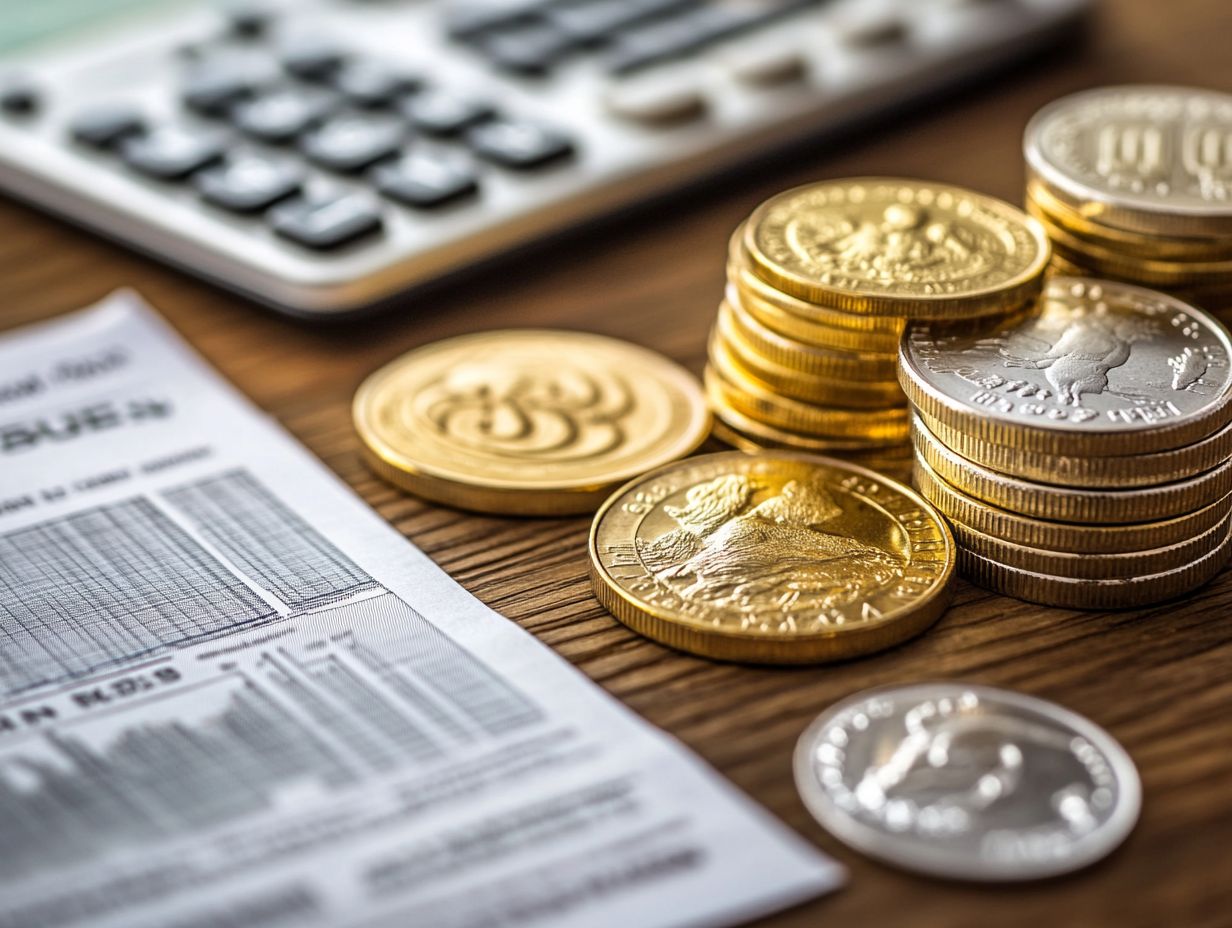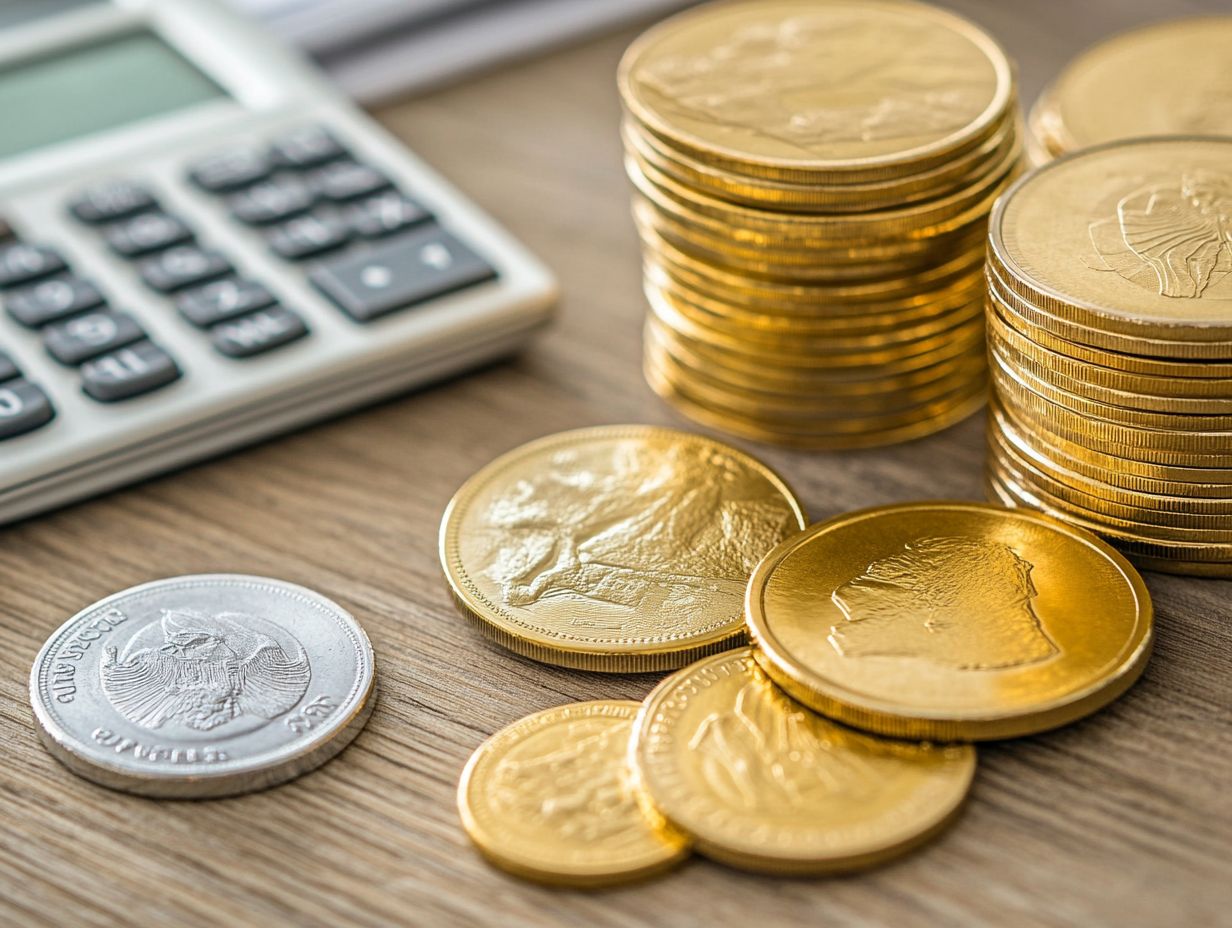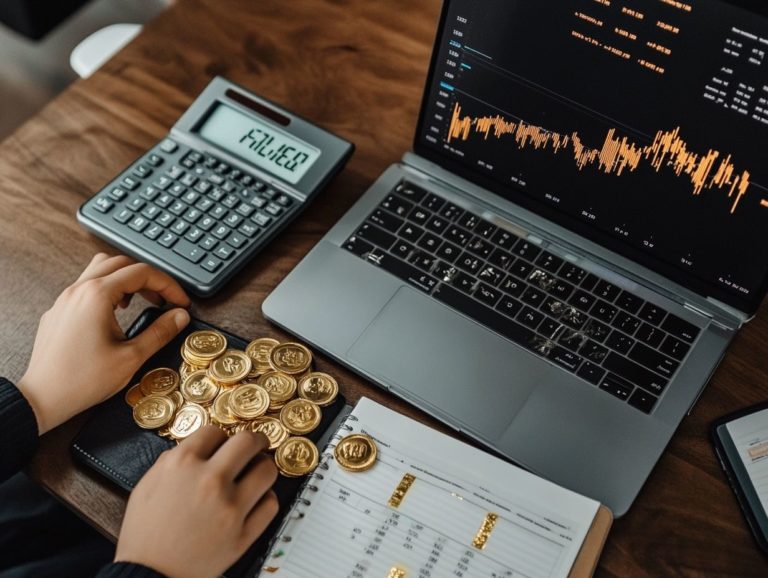Understanding the Tax Effects of Precious Metals Investments
Investing in precious metals has emerged as a sought-after strategy for diversifying portfolios and safeguarding your wealth. From gold and silver to platinum and palladium, these tangible assets come with their own distinct advantages and challenges.
As a potential investor, you’ll need to understand market changes and the taxes involved. This article delves into the allure of precious metals, outlines the tax obligations you may encounter, and offers strategies to minimize tax impacts.
By the end, you’ll confidently navigate the complexities of precious metal investments! Dive in to uncover the delicate balance of risk, reward, and tax planning in this ever-evolving investment landscape.
Contents
- Key Takeaways:
- The Role of Precious Metals in Investment Portfolios
- Tax Implications of Precious Metals Investments
- Strategies for Minimizing Taxes on Precious Metals Investments
- Factors to Consider Before Investing in Precious Metals
- Frequently Asked Questions
- What are the tax implications of investing in precious metals?
- Are there any tax breaks for investing in precious metals?
- Do I need to report my precious metals investments on my taxes?
- What is the tax rate for gains from investing in precious metals?
- Are there any special tax considerations for holding physical precious metals?
- Do I have to pay taxes on inherited precious metals?
Key Takeaways:

- Precious metals can add diversification and stability to investment portfolios, making them a popular choice among investors.
- Investors must be aware of the tax implications of precious metals investments, including capital gains tax and reporting requirements.
- Strategies such as tax-loss harvesting and utilizing retirement accounts can help minimize taxes on precious metals investments.
The Role of Precious Metals in Investment Portfolios
Investing in precious metals gold, silver, platinum, and palladium can significantly enhance your investment portfolio, especially during times of economic uncertainty.
These tangible assets act as a hedge against inflation. They also contribute to portfolio diversification, helping you balance risks and rewards effectively.
By integrating precious metals into your asset allocation strategy, you position yourself to improve the stability and performance of your overall investment portfolio. This capitalizes on their historical value and robust market demand.
Why Investors Choose Precious Metals
Investors often turn to precious metals like gold and silver as a strategic way to safeguard their wealth and hedge against the uncertainties of the economy and inflation.
By choosing these durable physical assets, you not only enhance the tangible value of your portfolio but also engage with a time-honored tradition that recognizes precious metals as safe havens throughout history. Demand for these commodities tends to surge during market volatility, as they are seen as dependable stores of value.
Incorporating these metals into your diversified portfolio can help mitigate risk and bolster your financial stability.
These investments aren’t merely about chasing immediate gains. They also act as a wise planning tool against inflation, ensuring that your wealth maintains its purchasing power even when economic conditions become challenging.
Tax Implications of Precious Metals Investments
Understanding the tax implications of investing in precious metals is crucial for you as an investor. These assets can notably influence your capital gains and overall tax liability.
The IRS classifies precious metals as collectibles. This means they are taxed differently from stocks or bonds, which may introduce intricate reporting requirements that you need to navigate carefully to ensure tax compliance and effectively minimize your taxable income. Understanding what investors need to know about gold tax laws is crucial for managing these complexities.
Capital Gains Tax on Precious Metals

As an investor in precious metals, it’s essential for you to understand the capital gains tax that comes into play when you decide to sell your assets. The IRS classifies these metals as collectibles, which means profit earned from these investments could be subjected to different tax rates compared to other asset sales.
Specifically, short-term capital gains those you realize from selling precious metals held for one year or less are taxed at your ordinary income rate, which can be considerably higher. On the flip side, long-term capital gains, which apply to metals you hold for longer than one year, benefit from reduced tax rates. Understanding the tax code for precious metals investments is crucial, making it essential for you to thoughtfully plan your selling strategies.
Grasping these nuances in IRS regulations can significantly impact the overall profitability of your investments in gold, silver, and other precious metals.
Reporting Requirements for Precious Metals
It s crucial to understand the reporting requirements for your precious metals investments. Accurate reporting of your sales and purchases to the IRS is essential for tax compliance.
Familiarize yourself with forms like the 1099-B, which tracks the proceeds from your transactions. When selling, consider both the profit or loss and the specific nature of the metals, as some have unique regulations.
Because the tax code for precious metals can be complex, consider enlisting the help of a financial advisor. They can help ensure your reporting is accurate, reducing the risk of errors that might lead to audits or penalties.
Strategies for Minimizing Taxes on Precious Metals Investments
To maximize your returns, it s important to implement effective strategies for minimizing taxes on your precious metals investments.
Tax-Loss Harvesting
Tax-loss harvesting is a valuable strategy for precious metals investors. It allows you to offset capital gains with any realized capital losses.
By selling underperforming assets, you can reduce your tax liabilities and enhance your overall investment returns. This strategy helps you manage market fluctuations while planning your taxes effectively.
Using Retirement Accounts

Investing in precious metals through retirement accounts offers significant tax advantages. This includes the possibility of tax-free withdrawals in some cases.
Options like a precious metals IRA can help diversify your portfolio while providing protective features. A traditional IRA allows for tax-deferred growth, letting you deduct contributions from your taxable income. Additionally, it’s important to consider the tax effects of precious metals trading when investing. A Roth IRA offers tax-free growth and withdrawals, provided you meet certain conditions.
Factors to Consider Before Investing in Precious Metals
Before investing in precious metals, consider several critical factors. Look at the current market value, evaluate economic conditions, and develop effective risk management strategies.
Risk vs. Reward Analysis
As an investor, conducting a risk versus reward analysis is vital for investing in precious metals. These assets have both great potential and inherent risks.
Examine the volatility of these commodities to make informed decisions about when to enter or exit the market. Historical performance can reveal patterns that guide your predictions and help evaluate the long-term viability of your investments.
Creating a balanced strategy with a diverse mix of precious metals can help mitigate risks while maximizing gains. Consider market trends, geopolitical factors, and currency fluctuations for a well-rounded portfolio.
Tax Planning for Long-Term Investments
Effective tax planning for your long-term investments in precious metals is essential for minimizing capital gains and optimizing your overall returns.
Adopting strategic tax approaches can significantly reduce your liabilities. This enhances your profitability over time.
Understanding different investment vehicles, like IRAs for precious metals, can lead to favorable tax outcomes. Get ahead by mastering these details!
Implementing strategies such as tax-loss harvesting and capitalizing on specific exemptions will help you preserve your wealth, even amid market fluctuations.
Staying proactive in your tax planning is crucial. It maximizes your financial benefits and ensures compliance with changing tax regulations.
Frequently Asked Questions

What are the tax implications of investing in precious metals?
Investing in precious metals can have various tax effects, depending on the type of metal and the way it is acquired. Generally, gains from the sale of precious metals are subject to capital gains tax.
Are there any tax breaks for investing in precious metals?
There are certain tax breaks available for investing in precious metals, such as the ability to use losses from precious metals investments to offset gains from other investments. However, these tax breaks may vary depending on the individual’s income and tax situation.
Do I need to report my precious metals investments on my taxes?
Yes, all investments in precious metals must be reported on your tax return. This includes purchases, sales, and any income or losses from these investments.
What is the tax rate for gains from investing in precious metals?
The tax rate for gains from precious metals investments is typically the same as the tax rate for capital gains, which can vary from 0% to 20% depending on the individual’s income and filing status.
Are there any special tax considerations for holding physical precious metals?
Yes, holding physical precious metals may have different tax implications compared to other forms of investment. For example, if you hold gold or silver bullion as a collectible, any gains from its sale may be subject to higher tax rates.
Do I have to pay taxes on inherited precious metals?
Inheriting precious metals can have different tax effects depending on how the inheritance is structured. In general, if you inherit precious metals as part of an estate, you may not owe taxes on them until you sell them. However, if you receive them as a gift, you may need to pay gift taxes if the value exceeds a certain threshold.
For comprehensive tax advice, consider consulting a tax advisor to navigate these complexities.













